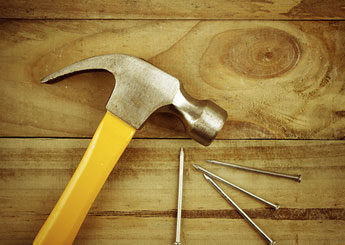Safe hammer handling

Photo: STILLFX/iStock/Thinkstock
A hammer is an impact tool – a tool used to drive items into material by way of manual or powered force – and, according to the National Safety Council, is a common source of injury. During safety inspections, supervisors need to be watchful that employees are not being careless with hammers. Many people do not follow best practices with hammers, as they often believe they know how to correctly use them.
All hammers should have a securely fitted handle suited to the type of head being used, the council notes. The handle, regardless of what it is made of, should be oil-free, shaped to fit the hand, and the correct size and length for the task. When using a hammer, protective eyewear should always be used to guard against flying chips, nails or scales.
One problem associated with using hammers is chipping. The head of the hammer may chip depending on these four factors:
- The more square the corners of the hammer, the easier it is to chip.
- The harder the hammer is swung, the more likely it is to be chipped.
- The harder an object is struck, the more the chance of chipping increases.
- The greater the angles between the surface of an object and the hammer face, the higher the chances of chipping.
Make sure to select the proper hammer for the job – one that is too light is just as unsafe and ineffective as one that is too heavy.
When driving a nail, hold the hammer close to the end of the handle. Use a light blow at first and increase the power of the blows once the nail is set. To better increase aiming accuracy, place the hammer on the nail before drawing it up to swing.
Post a comment to this article
Safety+Health welcomes comments that promote respectful dialogue. Please stay on topic. Comments that contain personal attacks, profanity or abusive language – or those aggressively promoting products or services – will be removed. We reserve the right to determine which comments violate our comment policy. (Anonymous comments are welcome; merely skip the “name” field in the comment box. An email address is required but will not be included with your comment.)

